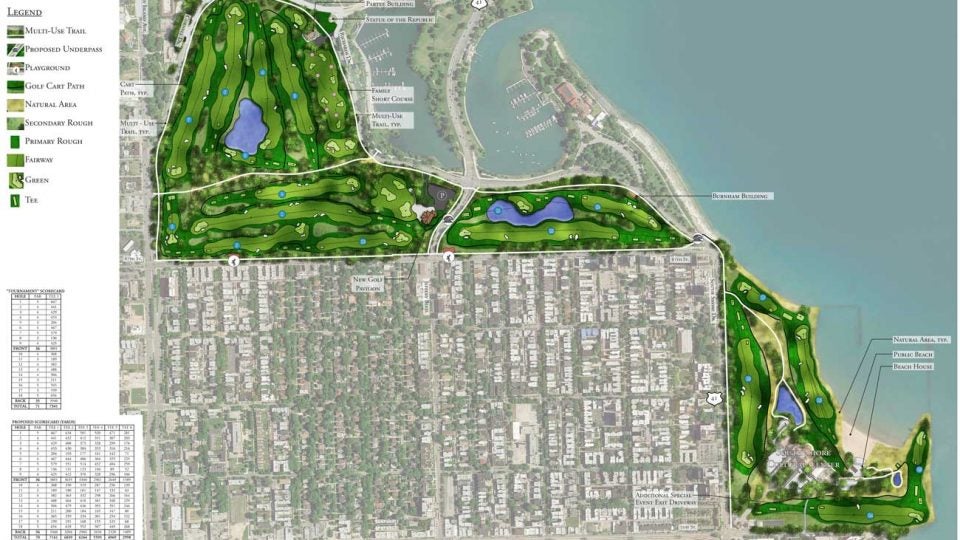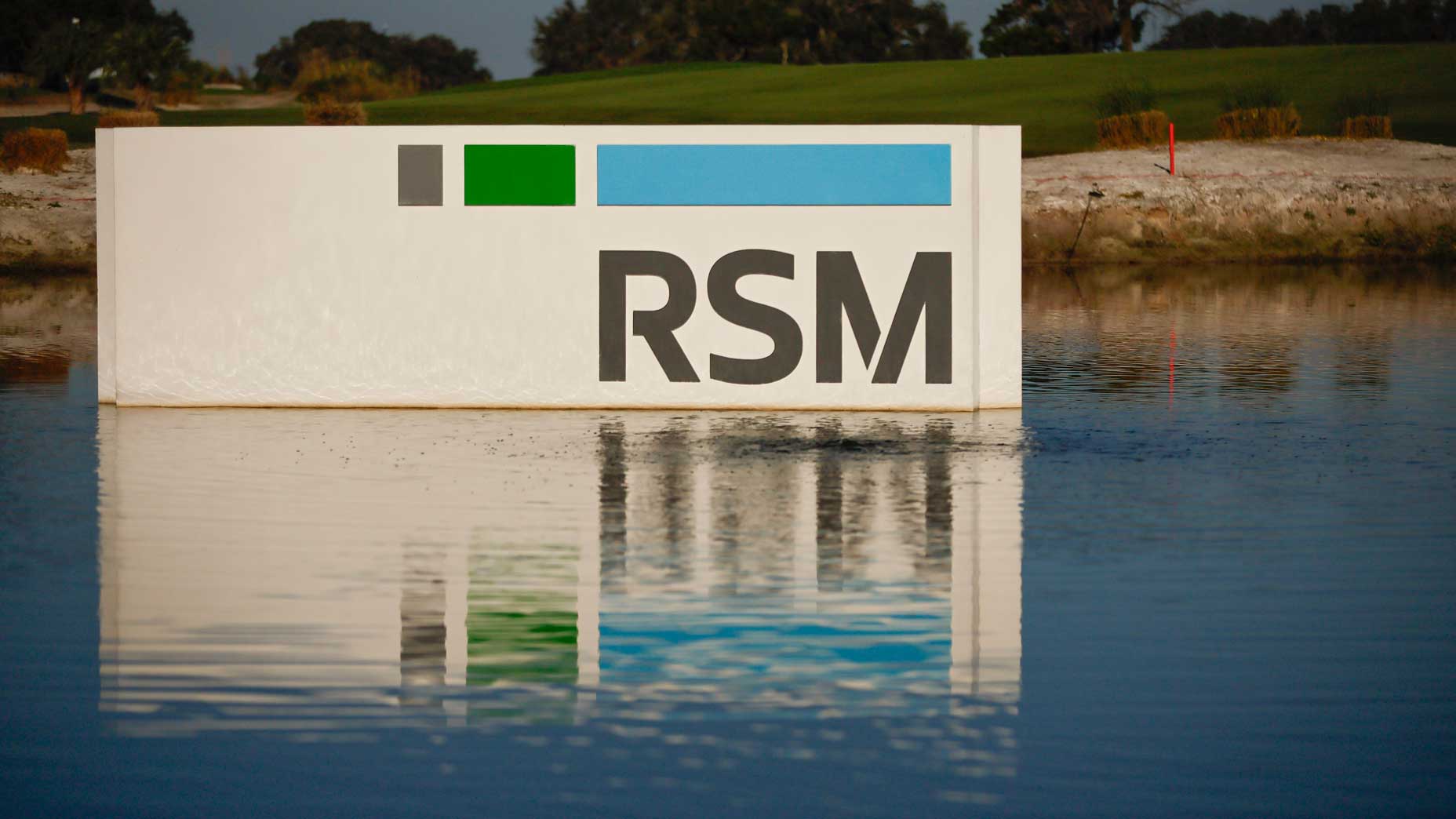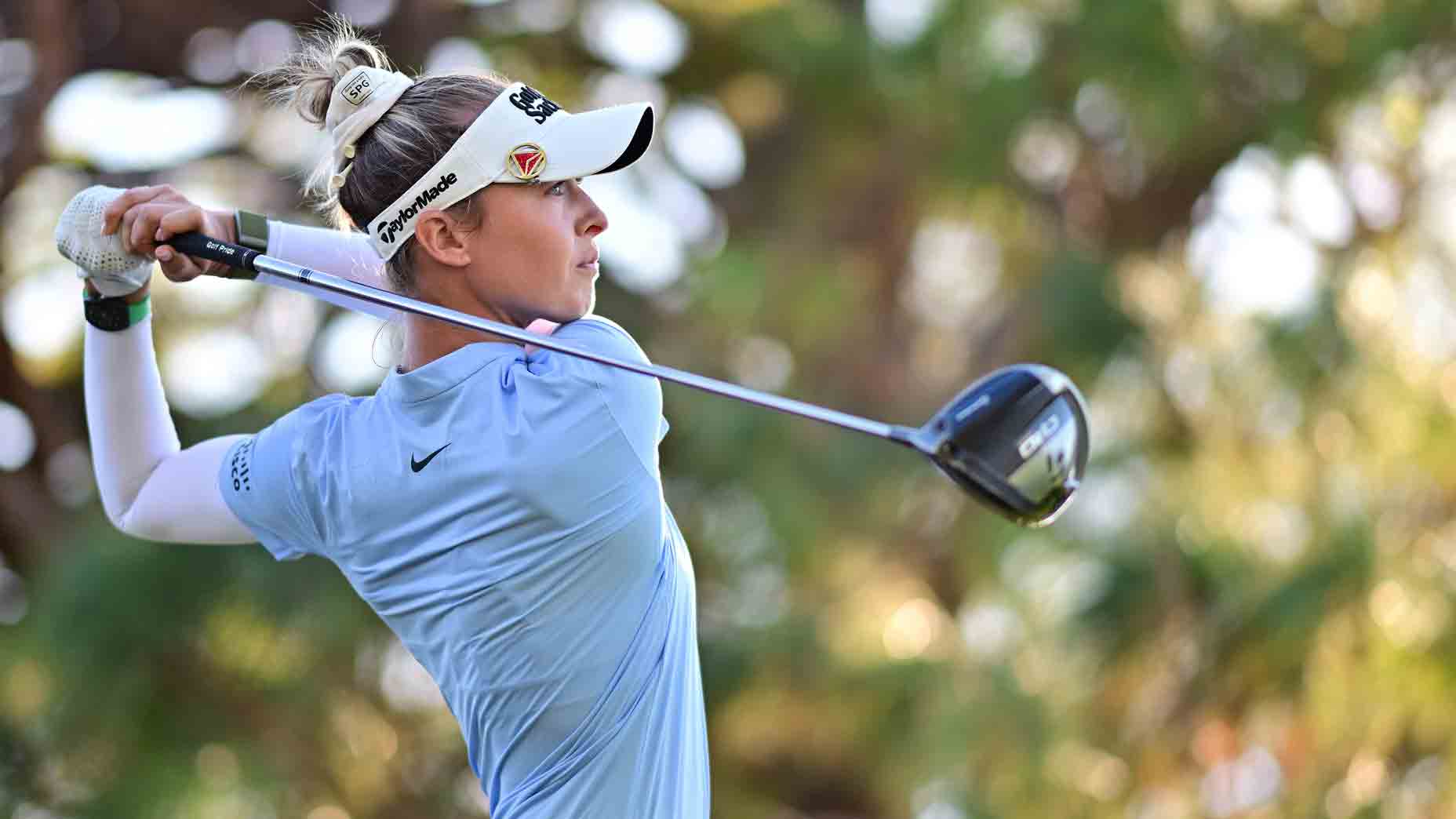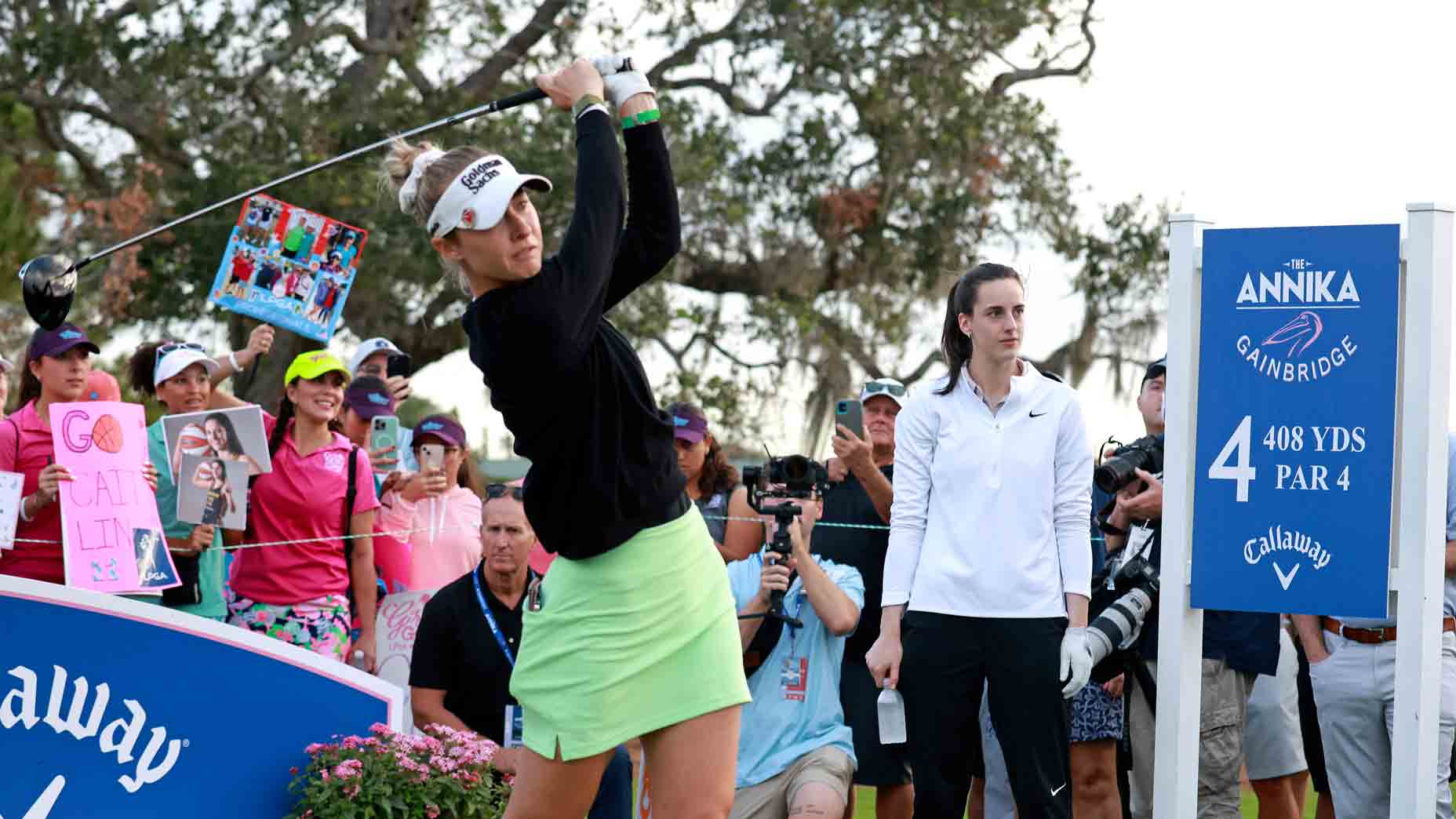At first glance, the whole plan seems too good to be true: How do you make a golf course that’s hard enough for the pros but accessible to a beginner? That’s built on the shores of Lake Michigan, has sweeping views of the Chicago skyline, and is designed by Tiger Woods? That’s cheap for local community members, free for kids under 17, but breaks even? And, most improbable of all: how do you construct a city-owned course that isn’t built with taxpayer dollars?
“I can’t tell you how many people told me from the beginning that we’d never get this through,” said Mark Rolfing, a longtime NBC/Golf Channel analyst and founder of the Chicago Parks Golf Alliance. “All kinds of reasons: too much red tape, or we’d never get past Chicago politics, or no way the community would go for it. Instead, I think we’ve got something that could be the model for city-owned golf going forward.”
The scope of the project is ambitious: it takes two existing Chicago-owned golf courses — 18-hole Jackson Park and 9-hole South Shore — and aims to connect them into a 7,341-yard championship muni that will welcome a Tour event and a local foursome in stride. Rolfing and Brian Hogan, co-founders of the Chicago Parks Golf Alliance, have worked extensively with community members and Woods’s design firm, TGR. And despite reports of slow-going, those in charge of the project feel as though it is well on its way.
The head of Chicago’s park district is certainly on board. “The Chicago park district has a proven track record of being the best deal in town,” said Mike Kelly, who runs the organization. “I see this as a crazy unique opportunity to combine the Obama presidential library and have Tiger Woods involved and it just seems like we can really blow the lid off this thing.” For Kelly, the kicker is the rate structure: free for kids 17 and under and less than $50 for Chicago residents, which would stand out for a course of this scope.
The next step in the process begins Wednesday evening, when the course’s new routing and fresh development plan will be presented to community members at the South Shore Cultural Center.
“We expect a lively but very positive reception tonight,” said Mike Kelly, the CEO of the Chicago Park District. “If and when we pull this off, I think it’s going to be a pretty significant national model for golf.”
Here’s what you need to know about the plan going forward:
THE COURSE
According to Beau Welling, senior design consultant for TGR Design, the latest changes to the routing have come directly from community input. One of the biggest differences in the new design is the relocation of the clubhouse, which ensured that the 9th and 18th greens will both come back to the course’s starting point.
“The demand was very strong for returning nines,” Welling said. “Which makes a lot of sense, because many of these players are used to playing at South Shore, which only has nine holes.”
An unintended benefit of shifting the clubhouse and the routing means that the featured stretch of lakeside holes shifts to later in the round. Holes 14-17 now run dramatically up against the lake.
“Most other cities that are on water, the Great Lakes in particular, the lakefront is industrial,” Rolfing said. “Cleveland, Detroit, Milwaukee, you understandably have industrial development on the lake. Here in Chicago we have park district land on the lake, which makes it a totally unique opportunity.” After leaving the 17th green, players will go through a tunnel to the 18th tee, where a monster par 5 tipping out at 654 yards awaits them. As they play in towards the clubhouse they’ll be hitting approach shots into the tall buildings of Chicago’s cityscape.
 As for the most famous golfer associated with the project? The word is that Woods has been hands-on throughout the process.
As for the most famous golfer associated with the project? The word is that Woods has been hands-on throughout the process.
“Tiger has been very involved,” Rolfing said. “I’m really quite impressed with the interest level and enthusiasm that he has shown. There have been really probably around 100 routing plans when you add them all up, and Tiger was involved in all of them. His vision for the big picture was an underlying factor in all of that.”
Rolfing explained that the course’s success will be based on its ability to tackle golf’s three biggest barriers: the game is too difficult, it takes too long, and it costs too much.
“We both share the feeling that the future really lies with public golf, particularly with our kids,” he said, referring to Woods. “If we don’t make an investment in our kids, the game is going to be in trouble.”
THE COMMUNITY
One of the challenges municipal courses face is providing a public recreational space while also operating as a profitable business.
“This is a public park, after all,” Welling said. “It’s got a lot of different people that use it and have ideas on how we should approach it, which has made this a very different type of process.”
Some changes are afoot. The new plan features more natural areas with trees, long grasses, and wildflowers that won’t inhibit play but will preserve the feel of the park. The design now turns an existing road that runs through the course into a pedestrian path, and will run to the clubhouse and all the way down to the lakefront. The designers hope it will help make the clubhouse a community gathering spot.
 The project’s timeline has also become aligned with the plans for the Obama Presidential Library, which is planned for just north of the course. “We had the opportunity to step back and say okay, let’s not just do a presidential center or an updated golf course,” said Hogan. “Let’s look at it holistically and see what we can do with the entire thing. We did a lot of listening, modifying, and mobilizing, and that’s gotten us here.”
The project’s timeline has also become aligned with the plans for the Obama Presidential Library, which is planned for just north of the course. “We had the opportunity to step back and say okay, let’s not just do a presidential center or an updated golf course,” said Hogan. “Let’s look at it holistically and see what we can do with the entire thing. We did a lot of listening, modifying, and mobilizing, and that’s gotten us here.”
The old clubhouse site will remain as a sort of home base for the course’s juniors and abuts the site’s short course. The First Tee will have a strong presence at the course as well.
“The single thing that I admire the most about Tiger is his desire to make meaningful golf courses,” Welling said. “I think he sees this as a legacy thing for him. He wants to make a positive impact around the game of golf. When this emerged as an opportunity, he jumped at it. He was like, ‘Oh my god, this is the kind of thing I’ve been wanting to get involved with so much.'”
The relatively flat, extremely walkable course will have a caddie program as well, designed to introduce kids to the game and allow them to make some money in the process. Woods has mentioned in the past the ability for caddie programs to open up the game to children from different backgrounds. A pilot program funded by the Western Golf Association was launched this year, with 10 caddies working at Jackson Park and earning around $60/round while being introduced to the game.
Welling hopes that the course, while utilizing modern design principles, can feel like it belongs on the historic site. “It seems appropriate that the golf course feels like it’s old and mature and has been here for years,” he said.
Golf courses have occupied the Jackson Park and South Shore sites since 1899, making the site one of the oldest public courses in the country. Before that, the land was used to host the 1893 World’s Fair, which commemorated the 400th anniversary of Christopher Columbus’ arrival in the New World.
THE MODEL
“One of the biggest problems city-owned golf courses face is that they pass along the costs of construction to their greens fees,” Rolfing said. “That wasn’t going to work here if we were going to keep it affordable for the community. And if we can’t keep it affordable for the community, we’re not doing that community any good.”
Thus was born the Chicago Parks Golf Alliance, which co-opted its model from building a park rather than a traditional golf course. Those involved in funding the project are doing so through donations, not investments, to get the project off the ground. “There is no return on the money being given,” Rolfing said. “It’s just for the good of the community.”
Rolfing said that the Alliance and the designers have been in touch with the PGA Tour since the beginning of planning and throughout the design process. While he doesn’t necessarily see its future as a major championship course, Rolfing says the BMW Championship, which is currently held in the Chicago area every other year, could find a home at the new course.
There’s no specific timeline on the project, but Rolfing says the 2021 BMW is one potential tournament they’ve targeted. “We really don’t think there’s anything like it,” Welling said, “and it’s different for us, too. The community is our boss, in this case. The people of Chicago are our boss.”








